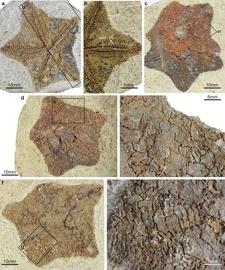Cantabrigiaster fezouataensis: A new Somasteroid Echinoderm from the Early Ordovician Fezouata Lagerstätte in Morocco.
[sciencythoughts.blogspot.com]
Asterozoans, whose most familiar members include Starfish and Brittle Stars, are the dominant group of extant Echinoderms based on their diversity, abundance and biogeographic distribution. Despite their ecological success and a fossil record spanning more than 480 million years, the origin and early evolution of Asterozoans, and those of crown-group Echinoderms more generally, remain uncertain given the difficulty of comparing the organisation of the calcified endoskeleton in diverse Lower Palaeozoic groups, such as the Edrioasteroids and Blastozoans. The extraxial–axial theory, which supports the homology of the biserial ambulacral ossicles of pentaradial and non-pentaradial Echinoderms based on embryonic and ontogenetic data, has been proposed as a developmentally informed model that facilitates comparisons among groups with disparate morphologies. Although the extraxial–axial theory can potentially clarify the early evolution of crown-group Echinodermata, the broad implications of this hypothesis have never been examined under a comprehensive quantitative phylogenetic framework. Consequently, the main phylogenetic predictions of the extraxial–axial theory, pertaining to the evolutionary relationships of Cambrian and Ordovician Echinoderms, such as the origin of the crown group from Edrioasteroid-like ancestors, although analysed with other homology schemes, have yet to be critically tested using the extraxial–axial theory.


Enjoy being online again!
Welcome to the community of good people who base their values on evidence and appreciate civil discourse - the social network you will enjoy.Create your free account
Recent Visitors 13
Sorcha
Baltimore,
Hathacat
IL, USA
Notlost
Northeastern Oklahoma,
Cast1es
Houston,
Charlene
Brookline Ma,
Photos 292 More
Posted by JoeBKite-like structures in the western Sahara Desert.
Posted by TriphidAn Aussie Indigenous Message Stick.
Posted by TriphidIndigenous Australian Aboriginal Rock art dated somewhere between 20 and 30 thousand years old.
Posted by TriphidIndigenous Australian Aboriginal Rock art dated somewhere between 20 and 30 thousand years old.
Posted by TriphidIndigenous Australian Aboriginal Rock art dated somewhere between 20 and 30 thousand years old.
Posted by TriphidIndigenous Australian Aboriginal Rock art dated somewhere between 20 and 30 thousand years old.
Posted by JoeBDortoka vremiri: A new species of Dortokid Turtle from the Late Cretaceous of the Hațeg Basin, Romania.
Posted by JoeBThe Cabeço da Amoreira burial: An Early Modern Era West African buried in a Mesolithic shell midden in Portugal.
Posted by JoeBMusivavis amabilis: A new species of Enantiornithine Bird from the Early Cretaceous Jehol Biota of northeastern China.
Posted by JoeBTorosaurus in Canada.
Posted by JoeBStone tools from the Borselan Rock Shelter, in the Binalud Mountains of northeastern Iran.
Posted by JoeBDating the Lantian Biota.
Posted by JoeBBashanosaurus primitivus: A new species of Stegosaur from the Middle Jurassic of Chongqing Municipality, China.
Posted by JoeBDetermining the time of year when the Chicxulub Impactor fell.
Posted by JoeBSão Tomé and Príncipe: Possibly the last country on Earth never to have been visited by a working archaeologist.
Posted by JoeBMambawakale ruhuhu: A new species of Pseudosuchian Archosaur from the Middle Triassic Manda Beds of Tanzania.
Members 658Top
Moderator
Related Groups
Religion of Science & Higher Consciousness
77 members
Political Posts, Articles and Memes
169 members
"I was blocked!?" Group
95 members
Conservative Bashers And Progressive Pushers
136 members
Trump Pinata
1142 members
FreeThinkers
2693 members
Progressives, Socialists, and Black/Palestinian Lives Matter
2460 members






